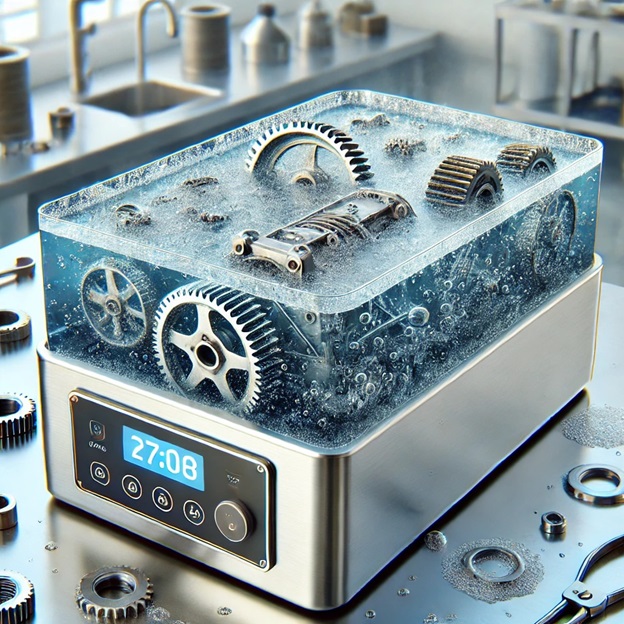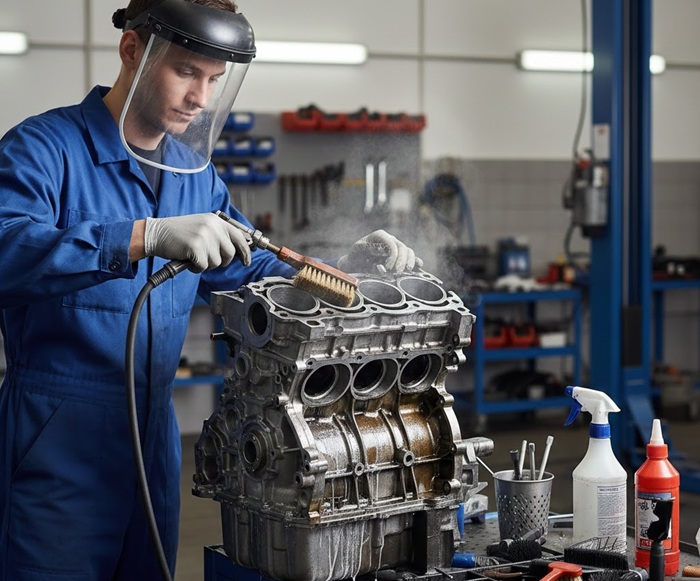
Most of the time, a rough-running car engine and a filthy carburetor are an indication that your vehicle requires proper service.
But there could be numerous reasons your car engine and parts aren’t running efficiently or not giving enough mileage.
Merely washing and quick cleaning might sometimes work, but a thorough inspection and professional servicing are often necessary to address underlying issues effectively.
Ignoring these signs could lead to more significant problems and costly repairs in the future.
No matter whether you run a professional garage or work as a part-time DIY enthusiast, cleaning your automotive engine and its parts using an ultrasonic cleaning device can be great fun.
In the article below, let’s check more about how ultrasonic cleaner for engine parts helps.
Ultrasonic Cleaning for Automotive Engine Parts
*At no extra cost to you, Ultrasonic-Cleaners.org may earn compensation if you make a purchase through links on this page.
These days’ ultrasonic cleaners are widely used for cleaning any shape and size of car engines. With the advent of these industrial cleaners, the old-fashioned solvent cleaners used in yesteryear’s neighborhood garages are entirely replaced.
Probably, you can recall how mechanics used to hold the engine under the faucet and practically scrub away the grease, oil, lubricant, and other contaminants on the automotive components.
But now, with the help of ultrasonic cleaners, all the repairmen need to do is – disassemble the car engine parts and place them in an ultrasonic cleaner tank to clean them efficiently and fast.
These cleaners are the best alternative if you want to speedily get rid of heavy built-up grease or badly choked-up engine parts like nuts and bolts in your car, truck, or speedster.
Thanks to the magic of ultrasound waves which work faster, much more safely, and efficiently for cleaning the engine parts, it now consumes a far lesser amount of time than it takes with traditional hand scrubbing of the engine parts (not only in the automobile industry but also in aircraft and marine industries).

How Does an Ultrasonic Cleaner for Car Engines Work?
Ultrasonic cleaner for auto parts consists of a wide stainless steel tank that can hold safe and biodegradable ultrasonic cleaning solutions for advanced cleaning results.
Remember to only use a premium quality ultrasonic cleaner solution for auto parts recommended by the manufacturer to keep the efficiency of the parts and the machine itself.
- When the device is turned On, the powerful transducer in the machine develops millions of microscopic bubbles in the cleaning solution.
- These bubbles implode with tremendous force by contacting the car engine parts.
- In the process, all type of grease, dirt, grime, and carbon deposit is stripped off completely without any damage.
- After completing the cleaning process, you need to rinse and dry off the auto parts to make them ready for re-assembling.
Although there are many smaller versions of ultrasonic cleaners for car engine parts available in the market, a machine with a bigger tank is mostly preferred for professional cleaning and repair.
This will help you to use the cleaner for cleaning various bigger-sized motor engine parts with much ease.

What Car Parts Can You Clean in an Ultrasonic Cleaning System?
The best thing about using ultrasonic cleaning systems for an auto mechanic is that you are free to go and complete your other productive tasks when the cleaning task is being done professionally by an automated machine.
You can return after a while and pick up the cleaned parts and tools when they are ready to assemble.
Although you can clean a range of automotive parts (of a car, motorcycle, or truck) using this device, the main engine components or parts that can be speedily cleaned by using these ultrasonic cleaning systems include:
- Carburetors
- Brake Cylinders
- Cylinder Heads
- Differential
- Rims & Wheels
- Jets & Orifices
- Pistons, Rings, Pinion Gears
Besides the above, small needle valves, intake and exhaust ports of a cylinder head, injector nozzle, and much more can be cleaned within a few minutes in these machines.
Removing the accumulated oil sludge, varnish, and carbon deposits from these engine parts manually by hand can be a tedious and long process.
But using an ultrasonic parts cleaner makes all this a breeze making it one of the most essential tools in the auto mechanic’s garage.
Besides Automotive Engine Parts, What Other Engines Can an Ultrasonic Cleaner Clean?
Beyond automotive applications, ultrasonic engine part cleaners can be used to clean components from various other types of engines across different industries, including marine, aerospace, industrial, and small engines.
The principle of using cavitation to remove contaminants like grease, oil, and carbon deposits applies widely to hard, non-absorbent materials.
Marine Engines
Ultrasonic cleaning is used in the marine industry for the maintenance and repair of inboard and outboard motors.
- Engine components: Cylinder heads, engine blocks, and pistons.
- Support systems: Oil filters, fuel supply pumps, valves, and heat exchangers, which effectively remove salt deposits, soot, and oil.
Aerospace Engines
The aviation industry has strict safety and cleanliness standards, making precision ultrasonic cleaning essential for maintenance, repair, and overhaul (MRO).
- Turbine engines: Turbine blades, vanes, and airfoils.
- Fuel systems: Fuel injectors and fuel nozzles, to remove stubborn carbon and oil deposits without damage.
- Other parts: Hydraulic system components, landing gears, and various electronic parts and sensors.
Industrial Engines
Large-scale industrial engines used in construction, agriculture, power generation, and mining also benefit from the deep cleaning capabilities of ultrasonic engine part cleaners and ultrasonic technology.
- Large assemblies: Large engine blocks and heavy metal parts are cleaned in industrial-sized tanks.
- System components: Diesel injection pumps, heat exchangers, gearboxes, hydraulic pump bodies, and filter packs.
- Emission systems: Large Diesel Particulate Filters (DPFs) and EGR coolers, which often become heavily choked with combustion materials.
Small Engines
For non-automotive consumer engines, such as those found in lawnmowers, chainsaws, and motorcycles, ultrasonic cleaning is highly effective.
- Small engine parts: Cylinder heads, and barrels.
- Miscellaneous: Nuts, bolts, screws, and tools used for maintenance
The machine is not only efficient for cleaning engine parts but also for various other items such as lenses, tattoo guns, razor blades, dentures, combs, and toothbrushes, among many more.
Final Thoughts
Choosing the best ultrasonic cleaner for engine parts ultimately comes down to understanding your cleaning needs and matching them with the right features. Ultrasonic cleaners offer a level of precision, consistency, and deep-cleaning power that traditional scrubbing or chemical soaking simply can’t achieve.
Whether you’re working with carburetors, injectors, valves, or intricate metal components, the combination of ultrasonic waves and a quality cleaning solution can restore parts to near-original condition with minimal effort.
When evaluating your options, prioritize tank size, power output, heating capability, and durability. A well-built unit not only speeds up your workflow but also protects the integrity of sensitive parts and reduces the need for harsh chemicals.
While these machines require an initial investment, the long-term payoff in performance, efficiency, and part longevity is significant.
